Vada Pav (Indian Spiced Potato Fritters)
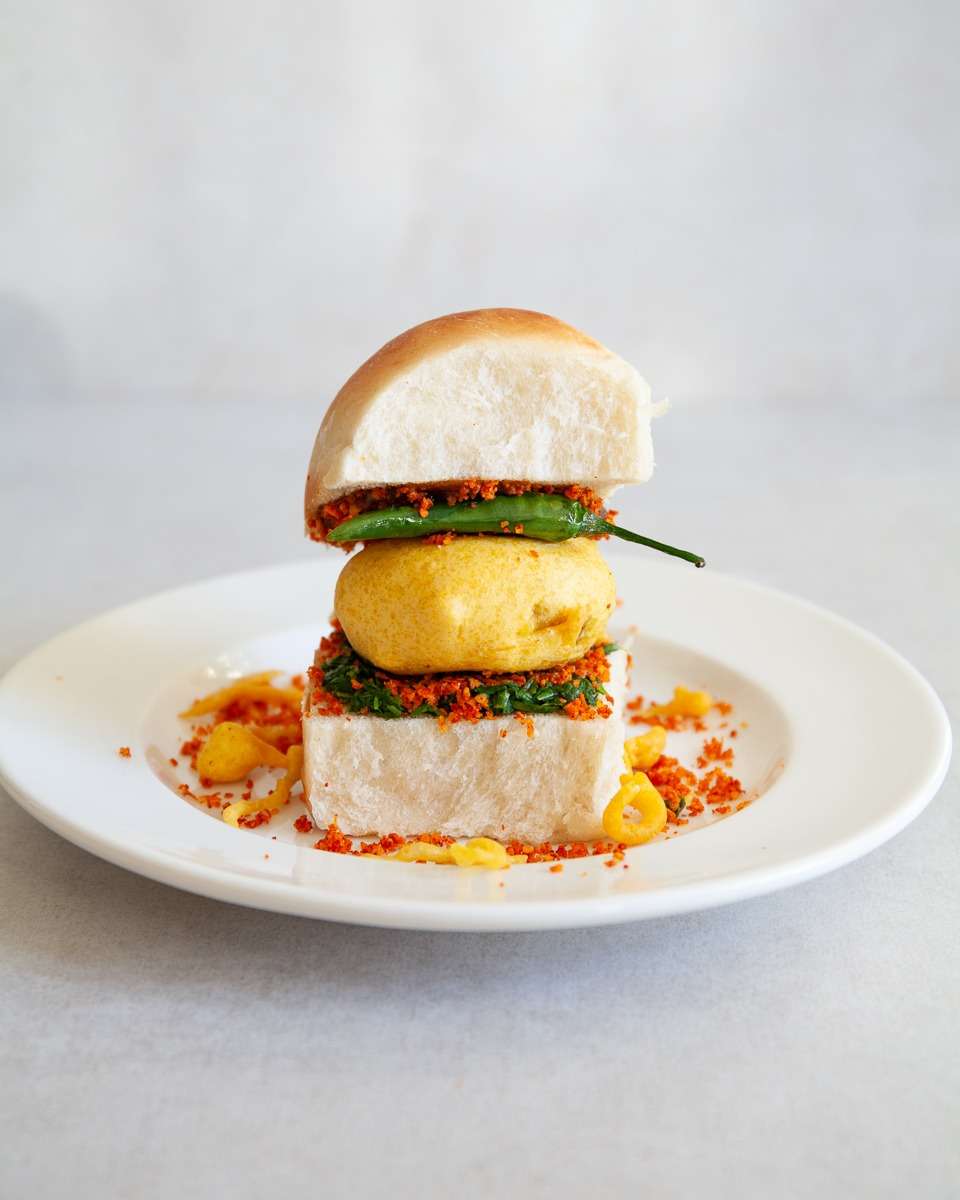
This is my step-by-step guide to crafting your own Vada Pav including the soft bread buns and all the chutney. It’s one of the best examples of the complexities of Indian food, where the chutneys and potato fritter create a beautiful balance of flavors and textures.
Although the recipe seems rather long, you can quite easily get all of the chutneys done while the potatoes are cooking. The tamarind chutney and the dry garlic chutney will also keep well in an airtight container in the fridge, so feel free to make a double batch and use them in other dishes, or as an excuse to make Vada Pav again soon…
A note of warning that deep-frying the whole green chillis will cause them to spit in the hot oil. You can pierce them with a knife before to avoid them from bursting, but unless you’re very keen or well-trained with frying, I’d recommend leaving them out. If you do fry them, take a few steps back after dropping them into the oil.
What is Vada Pav?
Vada Pav, often referred to as the “Indian burger,” (much to the dislike of locals) is a popular street food from Mumbai, India. It consists of a spicy potato fritter, known as the “vada,” sandwiched between a soft, fluffy bun called “pav.” The vada is made by mashing boiled potatoes and mixing them with spices, which is then coated in chickpea flour and deep-fried to golden perfection. The pav is typically slathered with a variety of chutneys, such as a green coriander chutney, a tangy tamarind chutney and a fiery garlic chutney, and is sometimes topped with a fried green chili for an extra kick. This beloved snack is a perfect blend of flavors and textures, making it a favorite among locals and tourists alike.
Vada Pav has humble beginnings in the bustling city of Mumbai, where it emerged as a quick, affordable, and filling meal for the city’s working class. It is believed to have been invented in the 1960s by Ashok Vaidya, a snack vendor who sold his creations outside Dadar railway station. With the influx of textile mill workers in Mumbai, Vada Pav quickly became a staple, offering a satisfying meal that could be eaten on the go. Over the years, it has grown beyond its street food roots to become an iconic symbol of Mumbai’s rich culinary heritage, loved by people across India and around the world.
Ingredients You’ll Need & How to Substitute
To make Vada Pav, you’ll need the following ingredients, some of which might not be available in common supermarkets, but can be found in most Indian grocery stores:
For the Potato Filling (Vada):
- Potatoes: The main ingredient for the vada, potatoes are boiled, mashed, and seasoned to create the spicy filling that forms the heart of the Vada Pav.
- Green Chilies: These add heat to the potato mixture, giving the vada its characteristic spiciness.
- Garlic: Garlic infuses the potato filling with a robust flavor that complements the other spices.
- Ginger: Ginger adds a warm, zesty flavor and pairs well with the garlic in the filling.
- Mustard Seeds: Used for tempering, these seeds add a subtle, nutty flavor and a slight crunch to the potato filling. Can be left out if not available.
- Turmeric Powder: Turmeric gives the potato filling a vibrant yellow color and a mild, earthy flavor.
- Asafoetida: Also known as hing, this spice adds a unique, savory depth to the filling, balancing the flavors. Onion or garlic powder can be used as a substitute if asafoetida is hard to find.
- Curry Leaves: Fresh curry leaves are fried with the spices to add a distinctive aroma and flavor to the filling. Can be left out if not available.
- Fresh Coriander Leaves: Coriander adds a fresh, herbaceous note to the potato mixture, enhancing its overall flavor.
For the Batter:
- Chickpea Flour (Besan): The main ingredient for the batter, chickpea flour forms a thick coating around the vada, giving it a crispy texture when fried. You can also make a batter out of wheat flour, if you prefer, though the flavor will be different.
For Frying
- Oil: Used to fry the vadas until they are golden brown and crispy. If you’d prefer to avoid deep frying, you can also pan-fry the coated patties in a non-stick frying pan, turning them every now and then, until the batter is cooked through.
For the Pav:
- Pav Buns: Soft, fluffy buns that are sliced and used to sandwich the vada. Any soft dinner roll or hamburger bun can replace traditional pav if needed.
For the Chutneys:
- Coriander Chutney: Made from coriander, green chilies and lemon juice, this chutney adds a fresh and slightly tangy layer to the Vada Pav.
- Tamarind Chutney: A sweet and tangy chutney made from tamarind and jaggery, it balances the heat from the vada and the green chutney. You can use tamarind paste instead of fresh tamarind (you’ll need to add less water) and light brown sugar instead of jaggery.
- Dry Garlic Chutney: A fiery chutney made from garlic, peanuts, desiccated coconut and kashmiri chili powder, it adds an extra punch of flavor for those who love heat. Use more coconut if you’d like to keep it peanut free.
Optional:
- Fried Green Chilies (for serving): Often served alongside or inside the Vada Pav for an extra kick of heat.
These ingredients come together to create the perfect Vada Pav, combining spicy, tangy, and savory elements in every bite!
How to make Vada Pav (step-by-step)
Start the Potato Filling. For the vada, add the potatoes to a pan, cover with cold water and season generously with salt. Then bring it to a boil and simmer for 30-40 minutes or until knife tender.
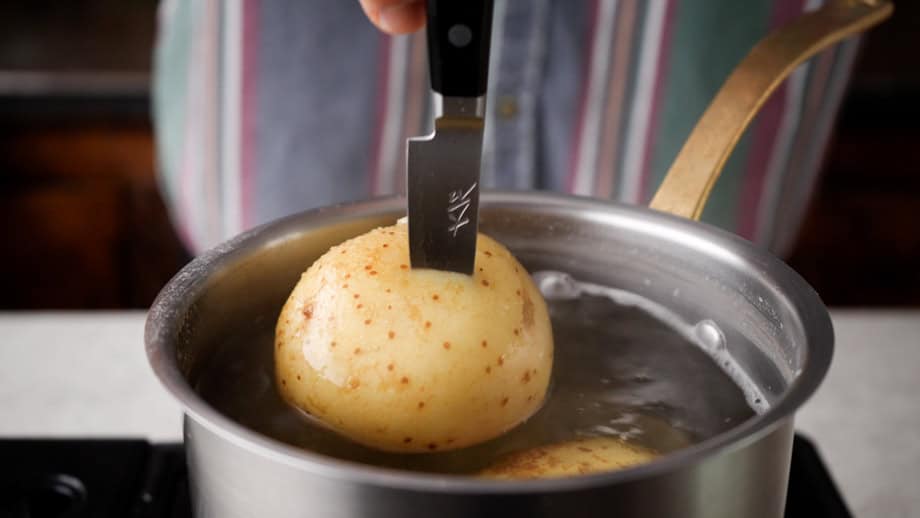
Drain the potatoes, leave them to cool a little, then peel and mash them.
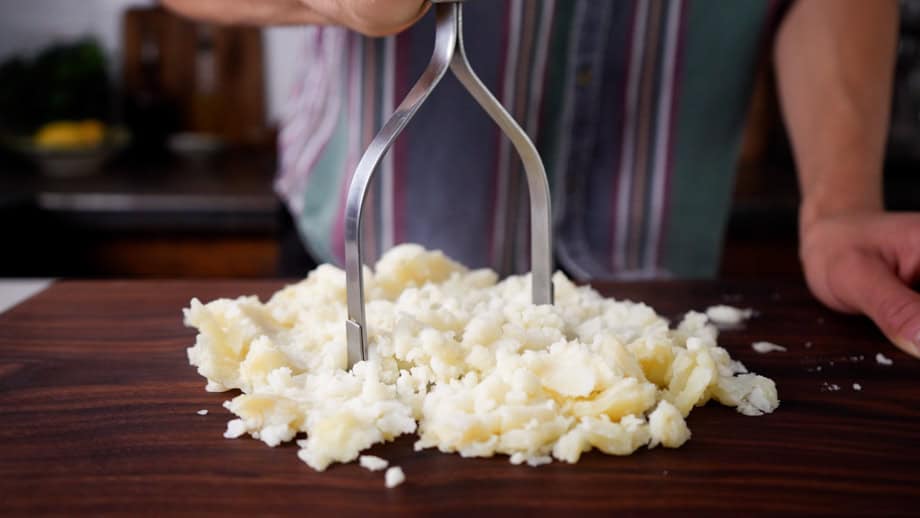
In the meantime make your chutneys.
Make the Tamarind Chutney. Break the tamarind into smaller pieces into a heat-proof bowl and cover with 200ml boiling water.
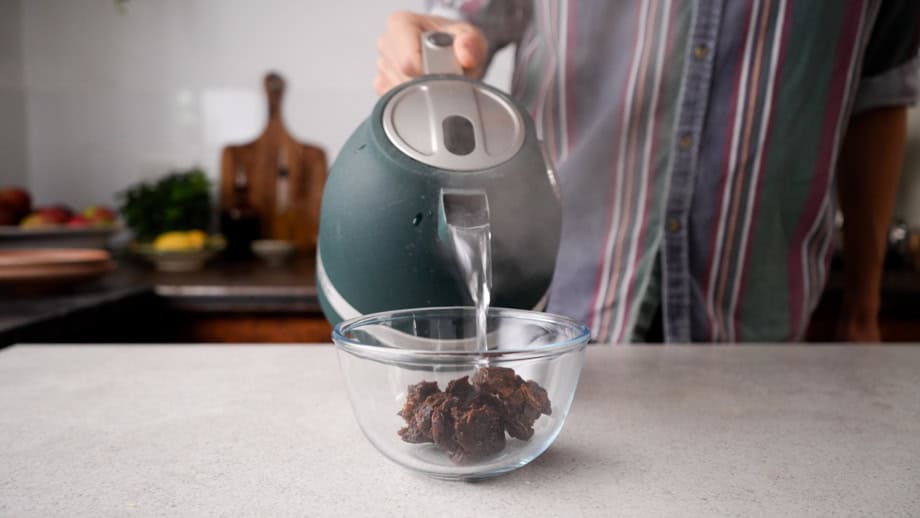
Leave to soak for 15 minutes, then use your hands to loosen the flesh from the fibrous strings. Place a sieve over a saucepan and strain the tamarind pulp, using a spoon to press through as much as possible and making sure to scrape the bottom of the sieve. Return the pulp to the mixing bowl and wash it with another 100ml water. Then strain into the saucepan again. Discard the pulp, then add the jaggery, cumin, ground ginger, chilli powder and 1/2 teaspoon of salt to the pan. Bring to a boil and simmer for 20 minutes.
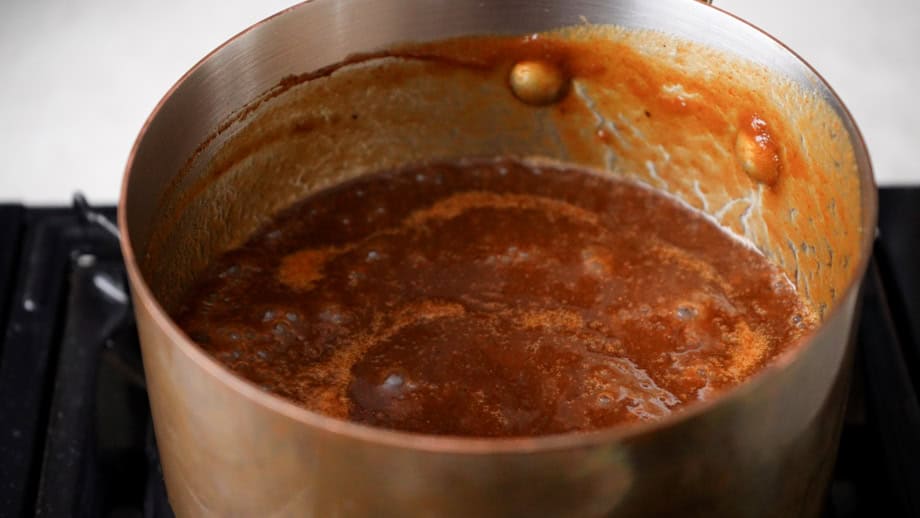
It should have thickened enough to coat the back of a spoon. Set aside until needed.
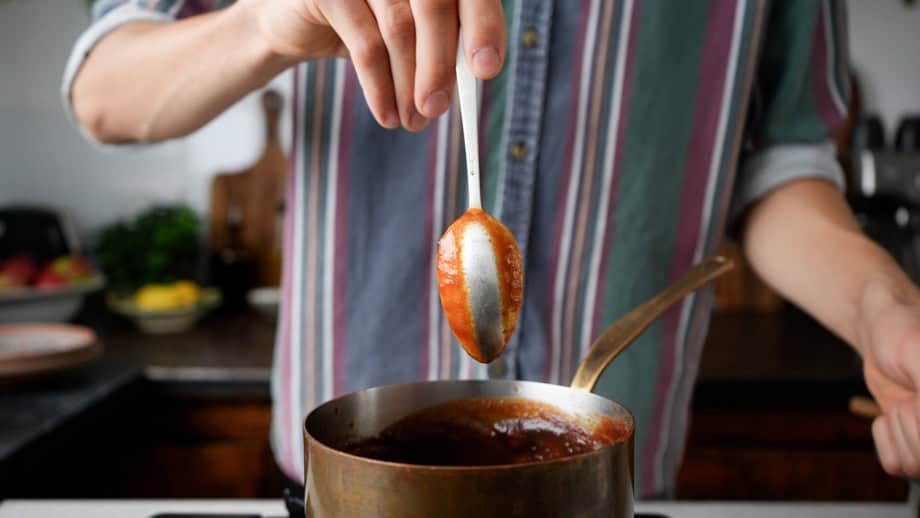
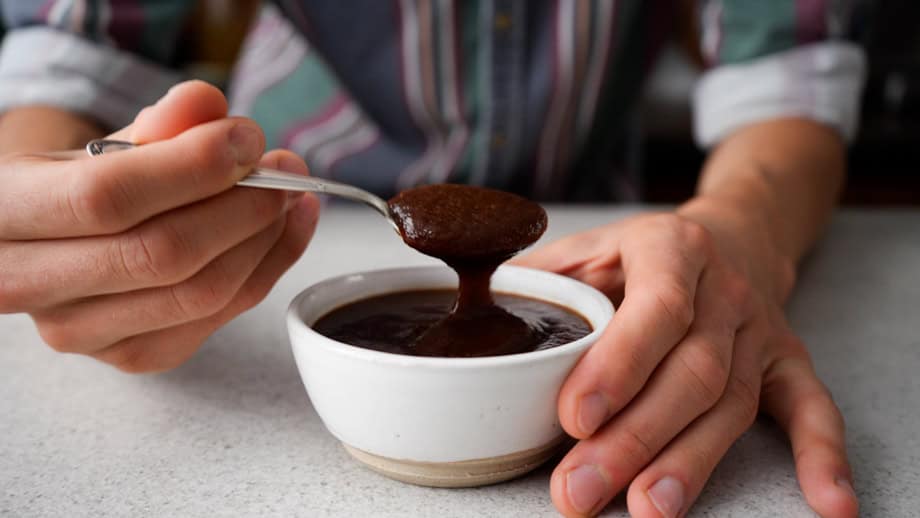
Make the Dry Garlic Chutney. Add the peeled garlic cloves and peanuts to a small frying pan and toast until they have golden spots all over.
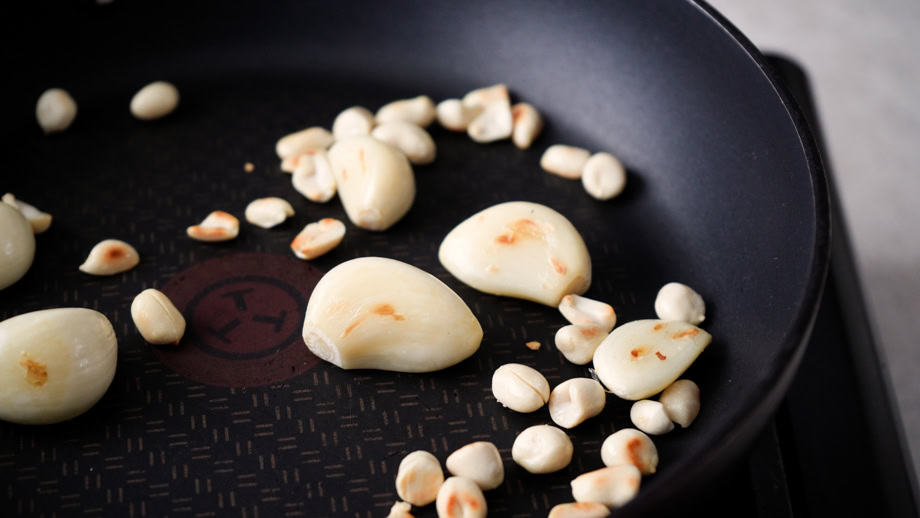
Stir in the desiccated coconut and continue toasting until it is golden throughout.
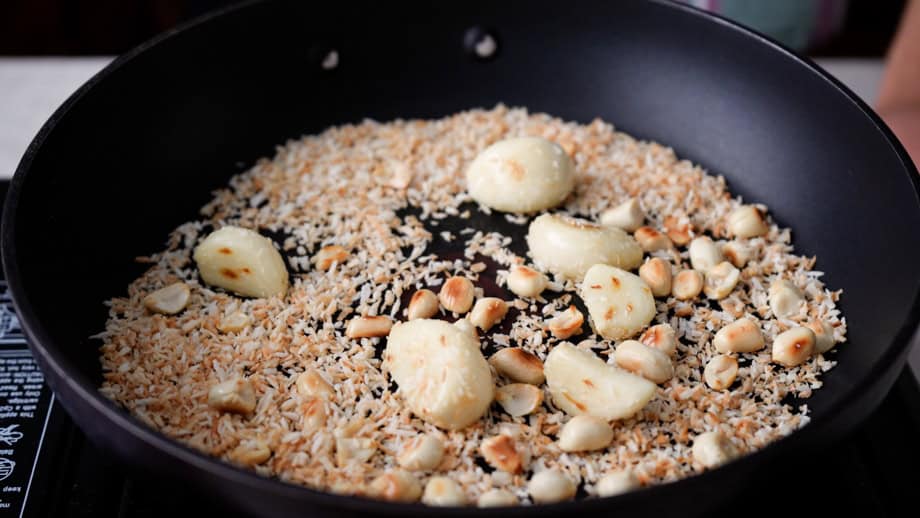
Then add everything to a food processor along with the chilli powder and 1/2 teaspoon of salt and pulse until fine and evenly red. Set aside.
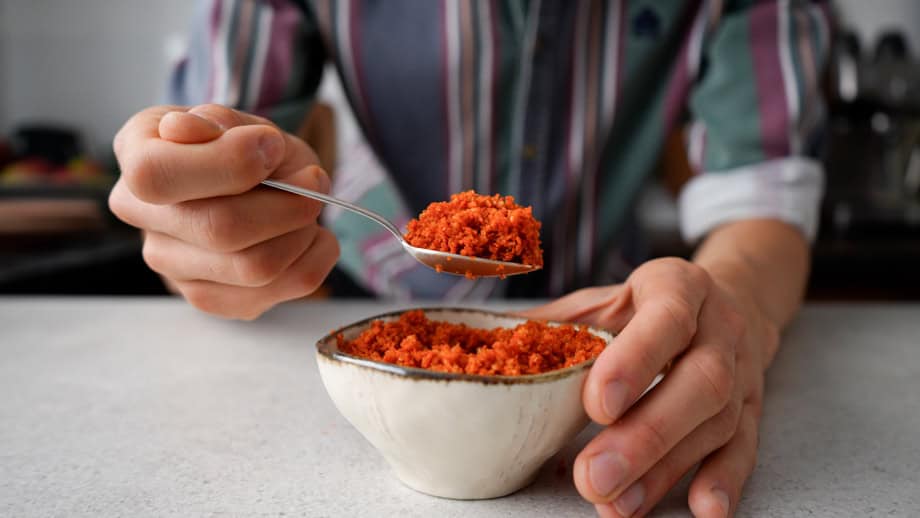
Make the Coriander Chutney. Follow this recipe to make a batch of the Coriander Chutney.
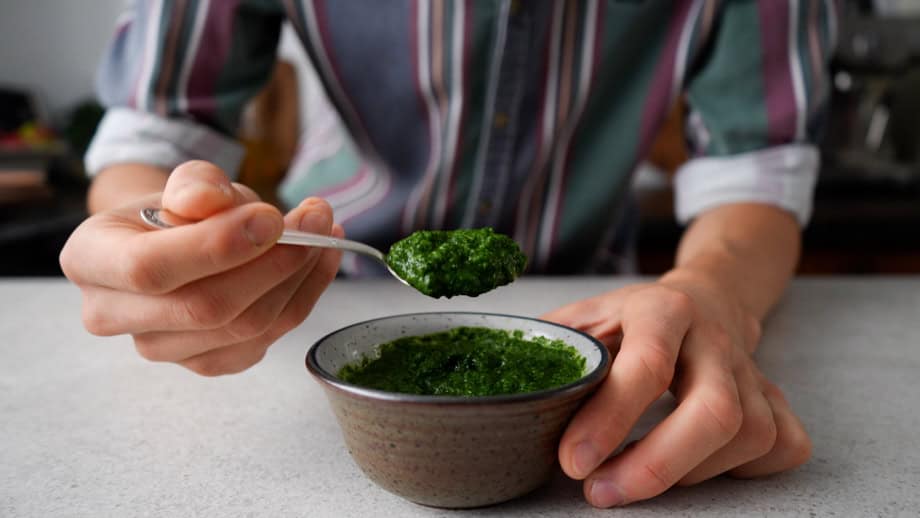
Continue the Vada. While the potatoes are cooling off, continue with the vada. Add the ginger, garlic and chilli to a pestle and mortar and mash them into a paste. Pick the curry leaves and roughly chop the coriander. When the potatoes are ready, heat some vegetable oil in a small frying pan. Add the mustard seeds and, as soon as they begin to sizzle vigorously, add the curry leaves and asafoetida followed by the ginger, garlic and the chilli paste. Sauté everything for around a minute until the garlic smells aromatic, then stir in the turmeric and turn off the heat. Add the mashed potatoes as well as the lemon juice, coriander and 1/2 teaspoon of salt. Tip it into a mixing bowl and, once cold enough to handle, use your hands to mix it evenly. Divide and shape the mixture into 8 balls, then flatten each ball into a thick potato patty.
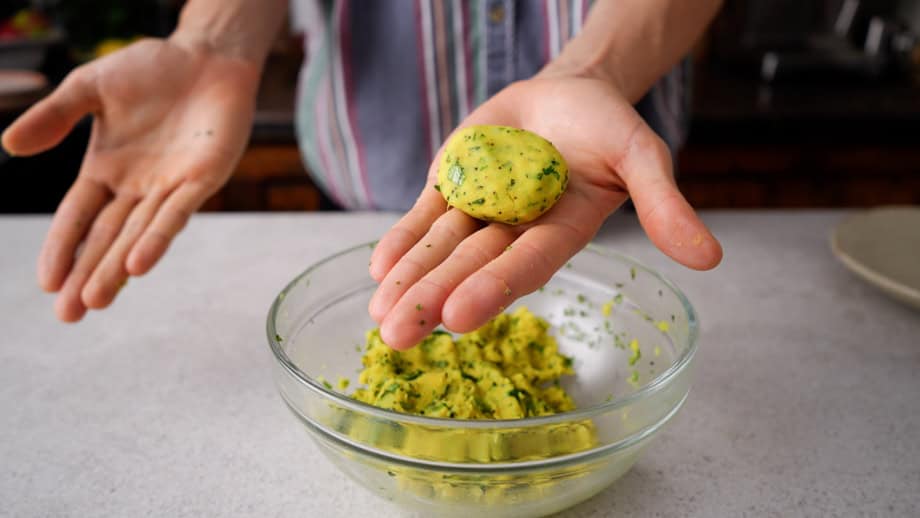
Make the Batter. Heat the vegetable oil in a sauce pan to around 170°C. In a mixing bowl, whisk together the ingredients for the batter along with 1/3 teaspoon of salt and 100ml water.
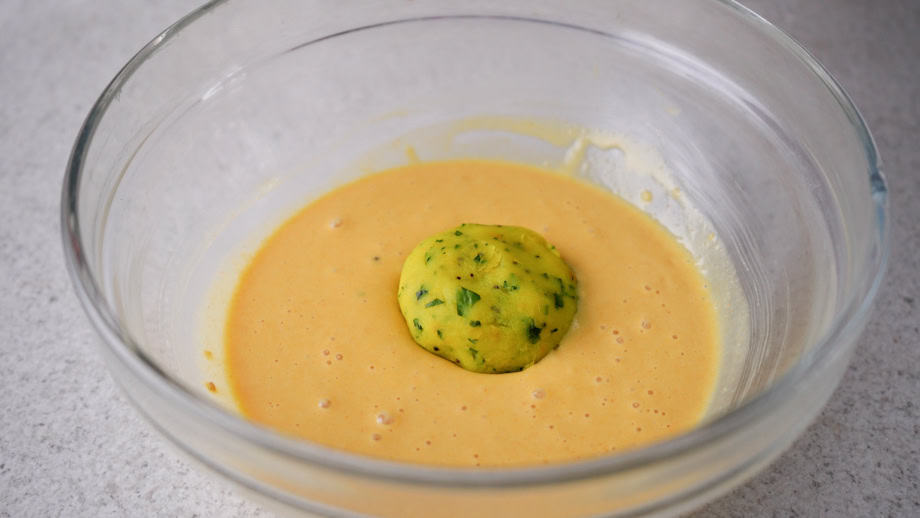
Fry the Vada. Coat 4 of the patties in the batter, adding them to the hot oil right away. Make sure that they don’t overlap or they might stick to each other. Fry the patties until golden and crisp on both sides (3-4 min), turning them every now and then, then remove with a slotted spoon onto a rack lined with kitchen paper and continue with the rest.

When you’ve finished the potatoes, drizzle around 4 tablespoons of the batter into the hot oil. They will puff up into light crispy bites called chura, which we’ll use as a garnish later.
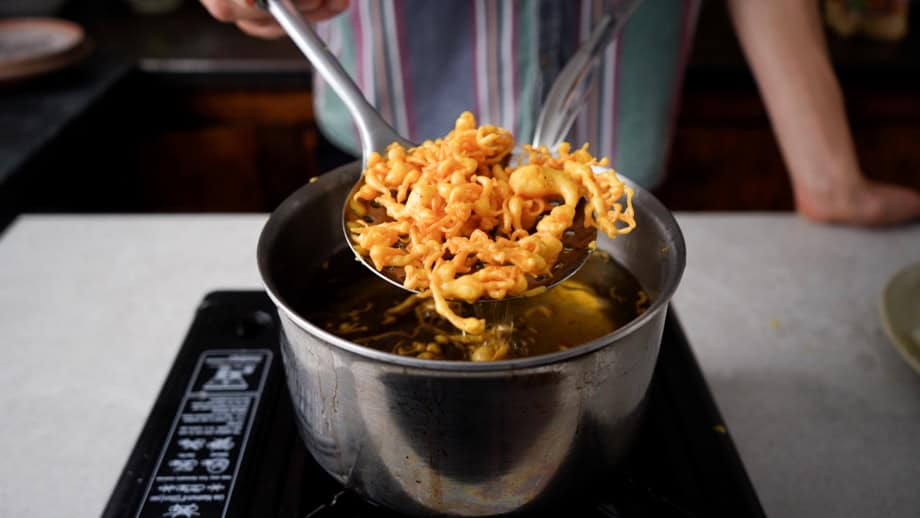
Only fry the remaining chillis if you’ve done this before and are confident with deep-frying, as they will spit in the hot oil. Reduce the temperature to around 140°C and pierce each chilli with a small knife to prevent them from bursting. Then place them on a slotted spoon and carefully dip it in and out of the hot oil, making sure to lift it up as soon as they sizzle. Continue this way until they stop sizzling in the oil and are blistered all over. Transfer to some kitchen paper to drain the excess oil.
Assemble the Vada Pav. Slice the buns in half, spread the coriander chutney over one side of the bun and the tamarind chutney over the other. Then sprinkle the dry garlic chutney over both.
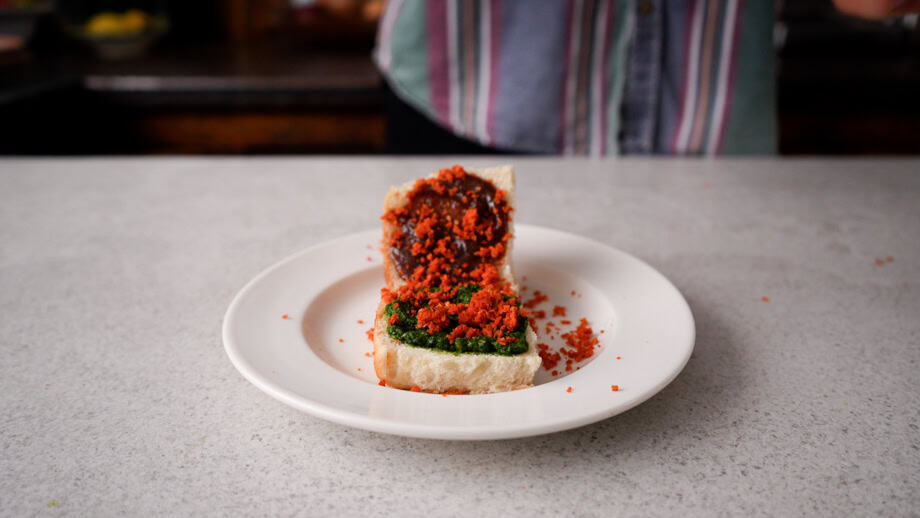
Place the vada on top followed by the chura and a fried chilli. Close the bun and serve straightaway with some more of the chutneys on the side.
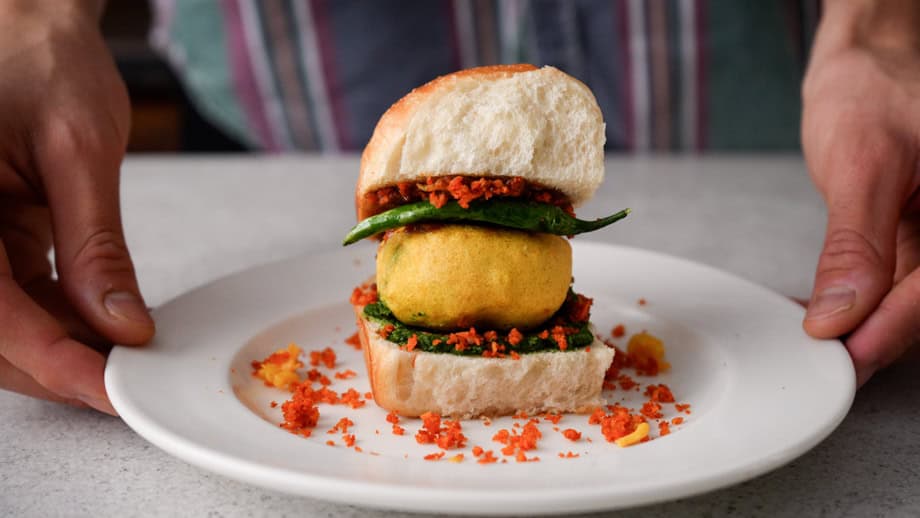
Useful Tips
- Consistent Batter: Ensure the chickpea batter is of the right consistency-not too thick, not too thin. This helps in evenly coating the vada for a perfect fry.
- Spice Level: Adjust the amount of green chilies and garlic chutney according to your heat tolerance. You can make it milder or spicier to suit your preference.
- Serving Fresh: Vada Pav tastes best when served hot and fresh. The pav should be soft and the vadas should have a crunchy exterior with a soft, flavorful inside.
- Green Chutney: To keep the vibrant green color, only add the lemon juice shortly before serving. The acidity will oxidize the herbs over time, turning them brown.
- Frying the Vada: Don’t overcrowd the pan, otherwise the temperature will drop and the vada might fall apart. Frying 4 vada at a time works well for me.
Why You’ll Love This Vada Pav Recipe
- naturally & traditionally vegan
- a powerful balance of sweet, tangy and spicy, with different textures and exciting flavor notes
- the key to three traditional Maharashtrian chutneys
- an authentic street food from Mumbai that can be prepared in your own kitchen
How to Store Vada Pav
While Vada Pav is best enjoyed fresh, you can store the components separately if needed. Keep the vadas in an airtight container in the refrigerator for up to 2 days. The garlic and coriander chutney can be stored in the refrigerator for up to a week in sealed jars, though the coriander chutney will lose its vibrant color once the lemon juice is added. The tamarind will keep well for a few weeks in the fridge. Assemble the Vada Pav just before serving to ensure the pav remains soft and the vada stays crispy.
Other Street Food Recipes You Might Like
- Mhajeb: Algerian flatbreads with a spicy harissa filling
- Çiğ Köfte: Spiced Turkish Bulgur Balls
- Pane e Cazzilli: Palermo’s answer to Vada
- Dosa: South India’s iconic fermented pancake
**I receive a small commission from affiliate links on this page**
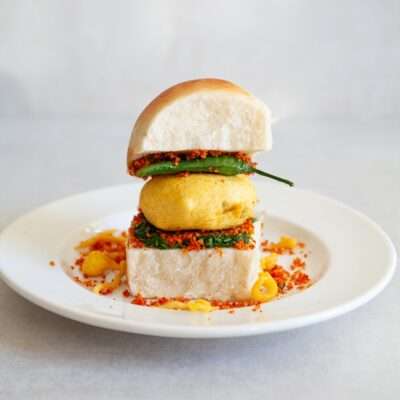
Vada Pav
Ingredients
For the vada
- 2 large potatoes (400g)
- 20 g ginger
- 2 garlic cloves
- 3 green finger chillis
- 30 small fresh curry leaves
- 20 g coriander
- 1 tsp brown mustard seeds
- 1/3 tsp asafoetida (hing)
- 1/3 tsp ground turmeric
- 1 tbsp lemon juice (1/2 lemon)
- 1 l vegetable oil for frying
For the tamarind chutney
- 100 g block of seedless tamarind
- 75 g jaggery (or golden granulated sugar)
- 1 tsp ground cumin
- 1 tsp ground ginger
- 1/4 tsp chilli powder
For the dry garlic chutney
- 6 large garlic cloves
- 1 tbsp raw peanuts
- 3 tbsp desiccated coconut
- 1 heaped tsp kashmiri chilli powder
For the coriander chutney
- 1 batch Coriander Chutney
For the batter
- 100 g gram flour
- 1/4 tsp turmeric
- 1/4 tsp asafoetida (hing)
To serve
- 8 green finger chillis (optional)
- 8 soft bread buns
Instructions
Vada
- Add the potatoes to a pan, cover with cold water and season generously with salt. Then bring it to a boil and simmer for 30-40 minutes or until knife tender. Drain the potatoes, leave them to cool a little, then peel and mash them. In the meantime make your chutneys as below.
Tamarind Chutney
- Break the tamarind into smaller pieces into a heat-proof bowl and cover with 200 ml boiling water. Leave to soak for 15 minutes, then use your hands to loosen the flesh from the fibrous strings. Place a sieve over a sauce pan and strain the tamarind pulp, using a spoon to press through as much as possible and making sure to scrape the bottom of the sieve. Return the pulp to the mixing bowl and wash it with another 100 ml water. Then strain into the sauce pan again. Discard the pulp, then add the jaggery, cumin, ground ginger, chilli powder and 1/2 tsp salt to the pan. Bring to a boil and simmer for 20 minutes until the chutney has thickened and coats the back of a spoon. Set aside.
Dry Garlic Chutney
- Add the peeled garlic cloves and peanuts to a small frying pan and toast until they have golden spots all over. Stir in the desiccated coconut and continue toasting until it is golden throughout. Then add everything to a food processor along with the chilli powder and 1/2 tsp salt and pulse until fine and evenly red. Set aside.
Coriander Chutney
- Follow this recipe to make a batch of the Coriander Chutney.
Vada (continued)
- While the potatoes are cooling off, continue with the vada. Add the ginger, garlic and chilli to a pestle and mortar and mash them into a paste. Pick the curry leaves and roughly chop the coriander. When the potatoes are ready, heat some vegetable oil in a small frying pan. Add the mustard seeds and, as soon as they begin to sizzle vigorously, add the curry leaves and asafoetida followed by the ginger, garlic and the chilli paste. Sauté everything for around a minute until the garlic smells aromatic, then stir in the turmeric and turn off the heat. Add the mashed potatoes as well as the lemon juice, coriander and 1/2 tsp salt. Tip it into a mixing bowl and, once cold enough to handle, use your hands to mix it evenly. Divide and shape the mixture into 8 balls, then flatten each ball into a thick potato patty.
- Heat the vegetable oil in a sauce pan to around 170 °C (338 °F). In a mixing bowl, whisk together the ingredients for the batter along with 1/3 tsp salt and 100 ml water. Coat 4 of the patties in the batter, adding them to the hot oil right away. Make sure that they don’t overlap or they might stick to each other. Fry the patties until golden and crisp on both sides (around 4 min), turning them every now and then, then remove with a slotted spoon onto a rack lined with kitchen paper and continue with the rest. When you’ve finished the potatoes, drizzle around 4 tbsp of the batter into the hot oil. They will puff up into light crispy bites called chura, which we’ll use as a garnish later.
- Only fry the remaining chillis if you've done this before and are confident with deep-frying, as they will spit in the hot oil. Reduce the temperature to around 140 °C (284 °F) and pierce each chilli with a small knife to prevent them from bursting. Then place them on a slotted spoon and carefully dip it in and out of the hot oil, making sure to lift it up as soon as they sizzle. Continue this way until they stop sizzling in the oil and are blistered all over. Transfer to some kitchen paper to drain the excess oil.
- Slice the buns in half, spread the coriander chutney over one side of the bun and the tamarind chutney over the other. Then sprinkle the dry garlic chutney over both. Place the vada on top followed by the chura and a fried chilli. Close the bun and serve straightaway with some more of the chutneys on the side.

Love this! I have always found it daunting to make this but your instructions are very easy to follow.
That’s wonderful to hear! Thanks!
Hey Julius !
Was wondering if the recipe would still work with dried curry leaves ? They’re all I can get my hands on unfortunately…
Thanks !
Yes, you absolutely can! I haven’t used dried curry leaves that way, to be honest, but I’d suggest scrunching them up before adding them. That way they should give a nice flavour. Hope you’ll like that Vada Pav!